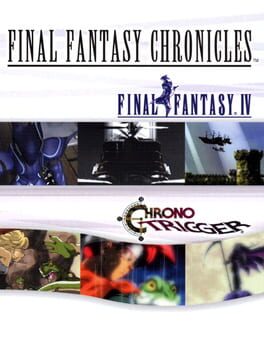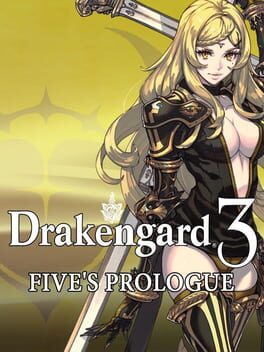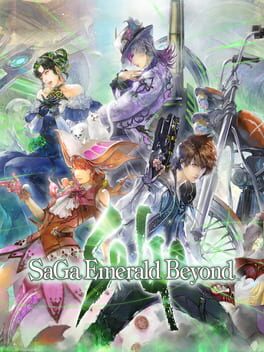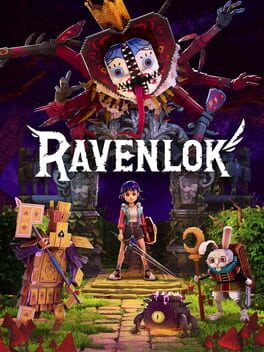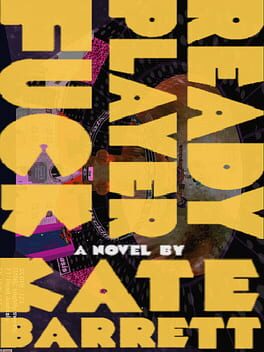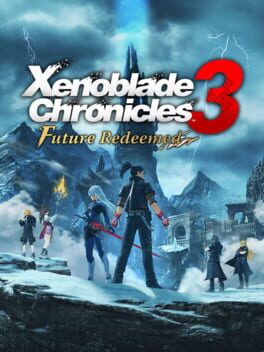felipelee
316 Reviews liked by felipelee
Originally, I posted a review comparing this game to other titles with a ton of depth that demand a lot from the player (like IIDX, +R, etc). I deleted that review, because I wasn't totally sure where I stood on the game after a few more races.
And then after doing even more races, I realized I was right the first time. This game fucking rules.
The tutorial is still awful, but I'm really glad I did it because I would not have thought to use stuff like quick drop without it, and the dialogue between Tails and Robotnik is endearing. It's probably the worst part of the game, and it's irrelevant after the first 45 min outside of the on-boarding process for new players. "Oh, you think you're hot shit? Beat this max CPU level race then" is based, actually.
Otherwise, it's a kart racer that asks more from you than most other entries in the genre, and that's rad. The ring system is sick as hell. The courses aren't all bangers, but an overwhelming majority of them are, and they all look and sound so good that you genuinely forget that the game is a fan project.
The Brawlesque unlock system is only frustrating if you want all the content at once and don't give a shit about the single player experience. The actual process of unlocking everything is, much like it was in Brawl, a fantastic way to encourage new players to plumb the depths of the game, and the key system lets you skip over any challenge you find especially egregious.
Nobody's mentioned the little pets that you can have follow you. I love having a little guy around me at all times for emotional support. No notes, should be a feature in more games in general.
This game is not trying to replace SRB2Kart, and divorced from the context of that game, I don't think it would have nearly as bad of a reputation. The average rating on this page has gone up steadily since this game's release, and as I posted before, in six months after the rough patches of the game are smoothed out (as they have been already in some cases!), it'll be appreciated for the home run that it is.
And then after doing even more races, I realized I was right the first time. This game fucking rules.
The tutorial is still awful, but I'm really glad I did it because I would not have thought to use stuff like quick drop without it, and the dialogue between Tails and Robotnik is endearing. It's probably the worst part of the game, and it's irrelevant after the first 45 min outside of the on-boarding process for new players. "Oh, you think you're hot shit? Beat this max CPU level race then" is based, actually.
Otherwise, it's a kart racer that asks more from you than most other entries in the genre, and that's rad. The ring system is sick as hell. The courses aren't all bangers, but an overwhelming majority of them are, and they all look and sound so good that you genuinely forget that the game is a fan project.
The Brawlesque unlock system is only frustrating if you want all the content at once and don't give a shit about the single player experience. The actual process of unlocking everything is, much like it was in Brawl, a fantastic way to encourage new players to plumb the depths of the game, and the key system lets you skip over any challenge you find especially egregious.
Nobody's mentioned the little pets that you can have follow you. I love having a little guy around me at all times for emotional support. No notes, should be a feature in more games in general.
This game is not trying to replace SRB2Kart, and divorced from the context of that game, I don't think it would have nearly as bad of a reputation. The average rating on this page has gone up steadily since this game's release, and as I posted before, in six months after the rough patches of the game are smoothed out (as they have been already in some cases!), it'll be appreciated for the home run that it is.
Final Fantasy Origins is an impressive little collection that bundles the Wonderswan remakes of Final Fantasy I & II for the PlayStation, with a slew of quality-of-life improvements that make Final Fantasy's earliest entries more accessible to new audiences without cheapening their "old school" difficulty. About the only impressive thing Final Fantasy Chronicles does is introduce intrusive load times and slowdown to Super Nintendo games in the year 2001 and with the full space of dedicated CDs at Square's disposal. Astonishing.
I'm sure there's worse ways to play these games. I know my ears wouldn't be able to tolerate a full playthrough of Final Fantasy IV for the Game Boy Advance, at least, but Chronicles is still less than ideal. I didn't tear into the technical aspects of the game in my review of FFIV, but the amount of slowdown here is agonizing. Scroll through your inventory mid-battle and watch it tick by like molasses slowly pouring from the tap. I also encountered a somewhat frequent bug where Rydia's summons would appear for a couple of frames and then vanish, taking any ensuing effects or damage along with them. Granted, I have no (contemporary) frame of reference to say whether these problems are unique to Chronicles or simply part of the FFIV experience, but it definitely hampers the experience of playing this release regardless.
Chrono Trigger is a game I don't currently have the motivation to sit down and fully replay, but I did mess around in it for a while just to get a sense of what the Chronicles edition was like. Bad, it turns out! The load times are so disruptive to the pace of the game that I can't see myself bearing it for a full play in the same way I can FFIV. You do at least get a nicely animated FMV intro, but hear me out: you can just watch that on YouTube before starting an ill-gotten SNES ROM up in your emulator of choice.
Final Fantasy IV also gets an FMV intro, but uhh... uhhhhhh.... Square was respected for the quality of their CGI cutscenes during the PlayStation era, so what happened here? Was all their money tied up with Spirits Within?
There are simply better ways to play these games, and the only real value I see in Chronicles today is if you're trying to fill out a PlayStation 1 collection and are still in the "I don't want to spend a lot on old games" phase of what is sure to be a mounting problem that will ultimately lead you to financial ruin, like it has me. It starts with this and then the next thing you know you're eyeballing copies of Ehrgeiz and Xenogears and contemplating taking out a loan. I'm writing this review on a Chromebook from the back of my 2003 Toyota Avalon, which I live out of now because i bought too many video games, please donate to my patreon i need to eat i promise i won't spend it on Suikoden II thats not who i am anymore i've changed!!
I'm sure there's worse ways to play these games. I know my ears wouldn't be able to tolerate a full playthrough of Final Fantasy IV for the Game Boy Advance, at least, but Chronicles is still less than ideal. I didn't tear into the technical aspects of the game in my review of FFIV, but the amount of slowdown here is agonizing. Scroll through your inventory mid-battle and watch it tick by like molasses slowly pouring from the tap. I also encountered a somewhat frequent bug where Rydia's summons would appear for a couple of frames and then vanish, taking any ensuing effects or damage along with them. Granted, I have no (contemporary) frame of reference to say whether these problems are unique to Chronicles or simply part of the FFIV experience, but it definitely hampers the experience of playing this release regardless.
Chrono Trigger is a game I don't currently have the motivation to sit down and fully replay, but I did mess around in it for a while just to get a sense of what the Chronicles edition was like. Bad, it turns out! The load times are so disruptive to the pace of the game that I can't see myself bearing it for a full play in the same way I can FFIV. You do at least get a nicely animated FMV intro, but hear me out: you can just watch that on YouTube before starting an ill-gotten SNES ROM up in your emulator of choice.
Final Fantasy IV also gets an FMV intro, but uhh... uhhhhhh.... Square was respected for the quality of their CGI cutscenes during the PlayStation era, so what happened here? Was all their money tied up with Spirits Within?
There are simply better ways to play these games, and the only real value I see in Chronicles today is if you're trying to fill out a PlayStation 1 collection and are still in the "I don't want to spend a lot on old games" phase of what is sure to be a mounting problem that will ultimately lead you to financial ruin, like it has me. It starts with this and then the next thing you know you're eyeballing copies of Ehrgeiz and Xenogears and contemplating taking out a loan. I'm writing this review on a Chromebook from the back of my 2003 Toyota Avalon, which I live out of now because i bought too many video games, please donate to my patreon i need to eat i promise i won't spend it on Suikoden II thats not who i am anymore i've changed!!
Guilty Gear
1998
Dragon's Dogma II
2024
Não existe outro jogo que eu conheça fazendo o que é feito em dragon's dogma, seja o primeiro ou sua sequencia, seu mundo é fresco e parece se auto moldar as minhas andadas tudo parece uma grande maquete esperando pra ser passada por, apesar de seus problemas ele tem uma mão forte guiando sua criatividade e ideias.
Ele foi ótimo para mim ao ser aproveitado durante um longo período sem a necessidade de se rushar ou correr para o terminar, isso foi um traço que me chamou muita atenção nele e me lembrou dragon quest, franquia que possue esse mesmo tipo de "estrutura", inclusive não quero de deixar de falar o como esse e o primeiro jogo são uma grande reimaginação das ideias de dragon quest III+dragon quest ix obviamente bem diferente e original mas não consigo ignorar esse sentimento.
Nessa ultima sessão quero falar sobre seu grande spoiler e segredo fique avisado!!!.
O final de dragon's dogma II anda em uma linha tênue em ser incrível e bagunçado, seu ultimo desafio é um teste pra arrancar do jogador todo seu conhecimento e recursos acumulados durante a aventura e isso em conceito é maravilhoso, tenho só um grande problema de como começam a aparecer uma quantidade estúpida de inimigos por metro quadrado fazendo a exploração ser prejudicada.
Mesmo com isso seu final e mensagem pro jogador apesar de ser batida é linda, o ultimo "boss" ser apenas uma cutscene sendo um adeus para o seu mundo e o jogador é lindo.
Ele foi ótimo para mim ao ser aproveitado durante um longo período sem a necessidade de se rushar ou correr para o terminar, isso foi um traço que me chamou muita atenção nele e me lembrou dragon quest, franquia que possue esse mesmo tipo de "estrutura", inclusive não quero de deixar de falar o como esse e o primeiro jogo são uma grande reimaginação das ideias de dragon quest III+dragon quest ix obviamente bem diferente e original mas não consigo ignorar esse sentimento.
Nessa ultima sessão quero falar sobre seu grande spoiler e segredo fique avisado!!!.
O final de dragon's dogma II anda em uma linha tênue em ser incrível e bagunçado, seu ultimo desafio é um teste pra arrancar do jogador todo seu conhecimento e recursos acumulados durante a aventura e isso em conceito é maravilhoso, tenho só um grande problema de como começam a aparecer uma quantidade estúpida de inimigos por metro quadrado fazendo a exploração ser prejudicada.
Mesmo com isso seu final e mensagem pro jogador apesar de ser batida é linda, o ultimo "boss" ser apenas uma cutscene sendo um adeus para o seu mundo e o jogador é lindo.
SaGa: Emerald Beyond
2024
A máxima acepção de SaGa como uma obra cuja história é sobre histórias: compreendendo que SaGa Scarlet Grace se inspira e assemelha-se aos títulos da série Romancing - na qual há uma elaborada construção de mundo a modo que ele seja um espetáculo para pequenas e sucessivas histórias -, Emerald Beyond baseia-se no que SaGa Frontier foi: Um mundo de mundos e mundos, no qual a incongruência gera histórias totalmente individuais, e que tampouco interagem entre si. SaGa Frontier se opõe a meticulosa e elaborada ordem que Romancing SaGa cria, gerando um universo totalmente caótico, mas que não soa tão desarmonioso, já que um dos principais pontos da série SaGa é ser uma obra cuja a história é sobre histórias.
É sob tal panorama que Emerald se desdobra: um jogo, que mesmo adotando a base narrativa do Scarlet, cria uma série de mundos com histórias particulares. Aqui o ponto não é exatamente impor ao jogador uma história tradicional onde se há um início, meio e fim bem delimitado, mas trazer o jogador à dinâmica daquele mundo, que pode ser semelhante a nossa realidade, ou até mesmo absurdamente estranho a ponto de ser cômico.
É perceptível a inspiração que o jogo toma para além do próprio Frontier: há elementos estéticos oriundos dos jogos mais antigos da série SaGa, e até mesmo algumas histórias parecem se inspirar em alguns conceitos dos jogos anteriores. Aliás, é interessante essa dicotomia que há de elementos oriundos do Scarlet com os dos jogos anteriores, pois é como se fosse uma dualidade do moderno entre o clássico. Não é algo que beira ao campo da intertextualidade, mas sim um aspecto fascinante e engraçado de se ver, como presenciar algum inimigo tradicional do Scarlet ao lado de uma fodenda lua com asas que tem uma língua maior que o cm de alguns que estão lendo.
Apesar de se inspirar fortemente no Frontier, há uma nuance entre ambos os jogos: enquanto Frontier se baseia no puro caos de espaço, onde a coexistência daqueles espaços soa incongruente, Emerald elabora uma razão para aqueles diversos mundos existirem. Partindo do famigerado “multiverso”, tal aspecto toma como o espaço em que os mundos se coexistem, não havendo mais aquela sensação de desordem que o Frontier possui (o qual deixando claro que não vejo isso como mérito do Emerald ou coisa do tipo, apenas como uma nuance)
Dito isso, Emerald Beyond para mim é um jogo que representa o oposto às coisas que Scarlet Grace me faz broxar. Não digo em relação ao que que comentei lá na introdução, mas sim sobre a dinâmica do combate, as quests extremamente obtusas, ao visual que eu acho extremamente feio... (sim, visual no sentido geral mesmo, acho esse jogo estupidamente feio D+). Em síntese, comparado ao Scarlet, para mim Emerald está há anos luz, porquê puta que me pario que jogo absurdo.
Apesar do meu exagero a cima, não julgo Emerald como um dos melhores da franquia (acho que nem iria entrar no meu top 5), mas é um jogo que representa algo que admiro da série: uma história sobre histórias.
É sob tal panorama que Emerald se desdobra: um jogo, que mesmo adotando a base narrativa do Scarlet, cria uma série de mundos com histórias particulares. Aqui o ponto não é exatamente impor ao jogador uma história tradicional onde se há um início, meio e fim bem delimitado, mas trazer o jogador à dinâmica daquele mundo, que pode ser semelhante a nossa realidade, ou até mesmo absurdamente estranho a ponto de ser cômico.
É perceptível a inspiração que o jogo toma para além do próprio Frontier: há elementos estéticos oriundos dos jogos mais antigos da série SaGa, e até mesmo algumas histórias parecem se inspirar em alguns conceitos dos jogos anteriores. Aliás, é interessante essa dicotomia que há de elementos oriundos do Scarlet com os dos jogos anteriores, pois é como se fosse uma dualidade do moderno entre o clássico. Não é algo que beira ao campo da intertextualidade, mas sim um aspecto fascinante e engraçado de se ver, como presenciar algum inimigo tradicional do Scarlet ao lado de uma fodenda lua com asas que tem uma língua maior que o cm de alguns que estão lendo.
Apesar de se inspirar fortemente no Frontier, há uma nuance entre ambos os jogos: enquanto Frontier se baseia no puro caos de espaço, onde a coexistência daqueles espaços soa incongruente, Emerald elabora uma razão para aqueles diversos mundos existirem. Partindo do famigerado “multiverso”, tal aspecto toma como o espaço em que os mundos se coexistem, não havendo mais aquela sensação de desordem que o Frontier possui (o qual deixando claro que não vejo isso como mérito do Emerald ou coisa do tipo, apenas como uma nuance)
Dito isso, Emerald Beyond para mim é um jogo que representa o oposto às coisas que Scarlet Grace me faz broxar. Não digo em relação ao que que comentei lá na introdução, mas sim sobre a dinâmica do combate, as quests extremamente obtusas, ao visual que eu acho extremamente feio... (sim, visual no sentido geral mesmo, acho esse jogo estupidamente feio D+). Em síntese, comparado ao Scarlet, para mim Emerald está há anos luz, porquê puta que me pario que jogo absurdo.
Apesar do meu exagero a cima, não julgo Emerald como um dos melhores da franquia (acho que nem iria entrar no meu top 5), mas é um jogo que representa algo que admiro da série: uma história sobre histórias.
Ravenlok
2023
A partir de um momento, eu simplesmente parei de prestar atenção e rushei pro final. Não só a história é extremamente clichê, se embebedando de Alice no País das Maravilhas, como não tem quase nenhuma dificuldade, o combate é praticamente socar um botão até o fim e a tradução para português é patética. A direção de arte me parece um dos poucos acertos aqui, mas nem isso consegue salvar o título de ser fraquíssimo.
Ravenlok
2023
Não tem muito o que falar, são 4 horinhas bem aconchegantes.
Artisticamente achei bem bonito, principalmente alguns monstros, o combate é bem simples e sem dificuldades.
Os únicos problemas são que em algumas lutas a câmera atrapalha um pouco e devido a estrutura das missões algumas coisas são confusas.
Artisticamente achei bem bonito, principalmente alguns monstros, o combate é bem simples e sem dificuldades.
Os únicos problemas são que em algumas lutas a câmera atrapalha um pouco e devido a estrutura das missões algumas coisas são confusas.
Ravenlok
2023
Quem da nota alta pra isso aqui nunca jogou outra coisa.
Brincadeiras a parte, sei que talvez eu não seja o público-alvo (por idade) desse jogo, mas já joguei muito jogo infantil excelente.
Pra não dizer que o jogo é inteiramente ruim, ele é bem bonito graficamente.
A estrutura de missões do jogo é ridículo, como alguém disse aqui no Backloggd "parece feito por IA". Busca um item alí pra abrir essa passagem aqui, e assim sucessivamente até o fim do jogo. O combate é porco, feito de qualquer jeito e a câmera semi-fixa é horrível, atrapalha demais.
Por que perdi meu tempo com isso? O jogo dropa conquista por tudo que você faz, respirou ganhou conquista.
Brincadeiras a parte, sei que talvez eu não seja o público-alvo (por idade) desse jogo, mas já joguei muito jogo infantil excelente.
Pra não dizer que o jogo é inteiramente ruim, ele é bem bonito graficamente.
A estrutura de missões do jogo é ridículo, como alguém disse aqui no Backloggd "parece feito por IA". Busca um item alí pra abrir essa passagem aqui, e assim sucessivamente até o fim do jogo. O combate é porco, feito de qualquer jeito e a câmera semi-fixa é horrível, atrapalha demais.
Por que perdi meu tempo com isso? O jogo dropa conquista por tudo que você faz, respirou ganhou conquista.
Pikuniku
2019
Pikuniku
2019
Ready Player Fuck
2017
Quando partimos do pressuposto de que a paródia é um exercício de intertextualidade, cujo objetivo é levar o interlocutor a fazer uma reflexão crítica sobre o conteúdo parodiado, Ready Player Fuck é um exercício bem raso que se debruça na premissa de que, só de profanar ao mesmo tempo todas as referências possíveis da cultura pop e geek, é uma ofensa primordial per se. Dava pra ser mais ofensivo, cutucar mais, profanar mais, do que só embrulhar um milhão de assets. Não é o suficiente. A arte ofende, e aqui vai ofender quem? O nerd com a "doença do sapo cego"? Já são minoria. Não deixo de considerar uma boa proposta, mas frente à liberdade e desprendimento das amarras da propriedade intelectual, poderia se propor a ser ainda mais ofensivo.
Ready Player Fuck
2017
A Cultura nerd precisa ser revisada.
É uma cultura que sequestra obras de arte em um culto egocentrico e excludente. Pessoas resgatam símbolos das obras para se identificar e vão enaltecer aqueles que reconhecem esses símbolos, que conseguem ler as referências e se sentem superiores por conta disso, mais popularmente culturados.
Ready Player Fuck sequestra esses símbolos em uma sátira divertida, engraçada e que não se importa com propriedade intelectual. Usando esses símbolos para mostrar o quão tosco e sem noção é esse imaginário coletivo do nerd boomer, que adora essas imagens religiosamente.
É uma cultura que sequestra obras de arte em um culto egocentrico e excludente. Pessoas resgatam símbolos das obras para se identificar e vão enaltecer aqueles que reconhecem esses símbolos, que conseguem ler as referências e se sentem superiores por conta disso, mais popularmente culturados.
Ready Player Fuck sequestra esses símbolos em uma sátira divertida, engraçada e que não se importa com propriedade intelectual. Usando esses símbolos para mostrar o quão tosco e sem noção é esse imaginário coletivo do nerd boomer, que adora essas imagens religiosamente.
'Three years had passed. Five years had passed, and still the trees remained with their roots spread out on the bottom of the water. It looked almost as if they were still alive now. Ohina thought to herself; in those days my legs were still strong. My eyes could still see far.'
– Michiko Ishimure, Tenko, 1997 (tr. Bruce Allen).
The post-war years in Japan were accompanied by an ideological shift in the ideas of work and family, with the development of the sarariiman myth. The ideal household, promoted by the Japanese government, was one in which the wife took care of the housework and the children's education, while the husband provided for the family's economic needs. This dream was made possible by the employment conditions of the 1960s and 1970s, when the average worker could expect to spend their entire career with the same company. Representations of the Japanese sarariiman have largely evolved over time, making him both an archetype of ideal masculinity through his loyalty to his employer and his sacrifice for his family (kigyō senshi, corporate warrior). At the same time, other representations emphasise his submissiveness, in line with the westernisation of Japanese culture [1].
And every morning the door closes
The collapse of the economic bubble in the 1990s shattered this ideal, weakening the labour market and the salaried middle class [2]. The destruction of this family harmony, based on a patriarchal concept of sacrifice, led to the dysfunction of Japanese households and the gradual disappearance of fathers from the family unit. The generation born after the 1970s had no memory of the economic miracle of previous decades and found themselves thrust into a world where inequalities were apparent from school and career prospects were mediocre at best. Authority figures were viewed with suspicion and contempt, including the government, teachers and parents. They are said to have failed in their role as guardians: teachers are portrayed as incompetent or murderers, politicians as indifferent to misery and colluding to steal public money, while fathers resign and mothers weep at their powerlessness [3].
The destruction of traditional masculinity, which is still struggling to build a new mythology, has been followed by a reassessment of the place of women, who are regarded as the driving force for Japan's economic recovery and the bulwark against demographic decline. Unsurprisingly, Shinzo Abe's economic programme has focused heavily on the role of women, both as workers and as mothers. Yet Abenomics have failed to transform the labour market environment: government coalitions have been largely conservative, and measures for women have been anemic at best [4]. What remains is a vain discourse to encourage reproduction – despite the economic conditions hardly being met for raising a child – which is reflected in cultural production.
Undoing ikumen in post-Abe Japan
The overrepresentation of motherhood, however, should not obscure the transformations of fatherhood in the 2000s and 2010s. Xenoblade Chronicles 3: Future Redeemed is a striking example as it deals directly with this issue, whereas the original game looked at the question of reproduction and family in a broader way [5]. The heroes of the first two games return, each embodying a different vision of masculinity. Shulk retains his candour while appearing more calm and disciplined. He represents a self-controlled masculinity driven by both elegance and intellect, in the style of the erudite warriors of pre-modern Asia. Rex is much rougher, constantly struggling to find a way to express his feelings and frustrations, despite his good intentions. In some ways, his development is reminiscent of that of Ryōta Nonomiya in Hirokazu Kore-eda's Soshite chichi ni naru (2013), an architect who is unable to provide emotional comfort to his family. Confronted with the way Shulk interacts with Nikol, Rex finds a new harmony with Glimmer, full of empathy and love.
Perhaps the most important aspect of these relationships is that their nature remains implicit. Many of the reminiscent and contemplative passages in Future Redeemed rely on knowledge of the franchise, but the theme of fatherhood runs throughout the DLC. Ultimately, the heroes' distance from their children is a response to the debates surrounding ikumen, a term used to describe fathers who are involved in raising their children in order to make them appear 'cool'. The ideological programme of Abe's Japan relied heavily on this imaginary to encourage fathers to participate in the household, but the figure of the ikumen has been widely criticised for giving men a nice label, even though they contribute to the dysfunction of both the domestic economy and their working environment [6].
The figure of the ikumen can be understood as a way for fathers to make themselves useful somewhere and gain recognition from their peers, a way to find a place to belong (ibasho) after being ejected from both the family unit and the corporate space. Future Redeemed responds to this sociological question in the same way as several local associations have done, through the figure of the ikimen, men who decide to foster communities of solidarity in the same way that they would look after their children [7]. Shulk and Rex, thanks to their experience, become the tutelary figures of the Liberators and Colony 9, but they are more interested in being mentors than leaders. Like the base game, Future Redeemed focuses on building bonds between the various members of the community until their resilience is no longer in doubt. As the various characters point out to Matthew, the virtue of a leader is to bring people together when necessary, not to control their lives. Through the various side-quests, the inhabitants of Colony 9 also gain texture and individuality, autonomy and confidence – more so than in the base game, thanks to a sparser cast.
Maybe tomorrow
There is an optimistic melancholy to Future Redeemed, between the series' various iconic locations reduced to lonely ruins and the forward-looking language of the characters. Like Tetsuya Takahashi's other games, the DLC shines by magnifying the ties that bind individuals, variations on the theme of friendship, love and togetherness – lessons that must be carried beyond the game. A single existence is but a drop in the ocean of human history. Civilisations, buildings, masterpieces, passions, dreams and memories can vanish in an instant, but there remains an explicit duty to cherish the past, not in blind adoration, but in preparation for the future. Future Redeemed constantly refuses to elevate Shulk and Rex onto a pedestal: they are already fading figures, as their injuries attest. Even A, for all her unwavering calm and penetrating gaze, chooses to remain outside the life that Colony 9 and the Liberators have decided to cherish; not because she is without compassion for the survivors, but because she knows – and this is her legacy – that the future belongs to them alone.
As Xeno veterans know, every story has an ending, and not all sequels need to be told. Looking back at Lost Jerusalem and thinking about building a better world is poignant, but this is the everyday story. Fighting for a fairer and more humane world. It may take generations, but the important thing is to keep dreaming and struggling for it, because there is nothing more tragic than an existence without hope, even when darkness seems to engulf everything. Of course, there is something idealistic and simplistic about this statement, but Future Redeemed, like the base game Xenogears (1998) or Xenosaga (2002-2006), leaves room for misery and sadness. Inequality is part of every society, and Takahashi has no illusions about the ghosts that will always roam the Rhadamanthus of the future. This is how Future Redeemed concludes the epic of the Xenoblade Chronicles, just as Episode III: Also sprach Zarathustra (2006) invited one to close their eyes for a while, until the light of hope reappears, maybe tomorrow. In a way, Future Redeemed is just an open door. Its more meticulous progression with Affinity Points, its more fluid exploration thanks to numerous ergonomic additions, and its gameplay designed around accessories rather than classes all point to rich ideas for Monolith Soft's next projects.
I may still be around to see what paths they take.
Maybe I won't.
I will sleep a while, until the dawn wakes me up again...
I still believe... come what may...
__________
[1] Annette Schad-Seifert, 'Samurai and Sarariiman: The Discourse on Masculinity in Modern Japan', in Arne Holzhausen (ed.), Can Japan Globalize? Studies on Japan's Changing Political Economy and the Process of Globalization, Springer, Berlin, 2001, pp. 206-208.
[2] Some contextual details are provided in my reviews of Kaze no NOTAM (1997) and Power Shovel (1999).
[3] This is a rather simplified picture of the cultural representations of the 1990s and 2000s, but they occupy an important part of successful audiovisual production in Japan. On the topic, see Shuk-ting Kinnia Yau, 'Bad Father and Good Mother: The Changing Image of Masculinity in Post-Bubble-Economy Japan', in David G. Hebert (ed.), International Perspectives on Translation, Education and Innovation in Japanese and Korean Societies, Springer, New York, 2018, pp. 243-253.
[4] Mark Crawford, 'Abe’s Womenomics Policy, 2013-2020: Tokenism, Gradualism, or Failed Strategy?', in The Asia-Pacific Journal, vol. 19, no. 4-4, 2021.
[5] On the topic, see my review of Xenoblade Chronicles 3 (2022).
[6] In particular, wives and employers are very suspicious of the ikumen modoki, the father who prides himself on being involved in running the household and bringing up the children, but in reality makes no effort at all. He builds a positive image of himself on his wife's efforts and uses the household as an excuse to shirk his professional responsibilities. The yarisugi ikumen, the man who is overly proactive in his domestic involvement, is equally feared by women, both because he often disrupts household routines and wastes time, unnecessarily burdening his spouse with additional work. On the topic, see Nicholas Michael Feinig, Rearing the Family, Moving Society: Rethinking Gender, Kinship, and Work through Japan’s Fathering Movement, PhD thesis, University of Toronto, 2020, pp. 99-134.
[7] This figure is also subject to specific criticisms, notably the contamination of spaces intended for women by a corporatist and hierarchical masculinity, and the fact that these groups are more places for fathers to socialise than spaces for improving local community life; nevertheless, they are a new ibasho for men, outside the workplace. On the topic, see Nicholas Michael Feinig, op. cit., pp. 230-276.
– Michiko Ishimure, Tenko, 1997 (tr. Bruce Allen).
The post-war years in Japan were accompanied by an ideological shift in the ideas of work and family, with the development of the sarariiman myth. The ideal household, promoted by the Japanese government, was one in which the wife took care of the housework and the children's education, while the husband provided for the family's economic needs. This dream was made possible by the employment conditions of the 1960s and 1970s, when the average worker could expect to spend their entire career with the same company. Representations of the Japanese sarariiman have largely evolved over time, making him both an archetype of ideal masculinity through his loyalty to his employer and his sacrifice for his family (kigyō senshi, corporate warrior). At the same time, other representations emphasise his submissiveness, in line with the westernisation of Japanese culture [1].
And every morning the door closes
The collapse of the economic bubble in the 1990s shattered this ideal, weakening the labour market and the salaried middle class [2]. The destruction of this family harmony, based on a patriarchal concept of sacrifice, led to the dysfunction of Japanese households and the gradual disappearance of fathers from the family unit. The generation born after the 1970s had no memory of the economic miracle of previous decades and found themselves thrust into a world where inequalities were apparent from school and career prospects were mediocre at best. Authority figures were viewed with suspicion and contempt, including the government, teachers and parents. They are said to have failed in their role as guardians: teachers are portrayed as incompetent or murderers, politicians as indifferent to misery and colluding to steal public money, while fathers resign and mothers weep at their powerlessness [3].
The destruction of traditional masculinity, which is still struggling to build a new mythology, has been followed by a reassessment of the place of women, who are regarded as the driving force for Japan's economic recovery and the bulwark against demographic decline. Unsurprisingly, Shinzo Abe's economic programme has focused heavily on the role of women, both as workers and as mothers. Yet Abenomics have failed to transform the labour market environment: government coalitions have been largely conservative, and measures for women have been anemic at best [4]. What remains is a vain discourse to encourage reproduction – despite the economic conditions hardly being met for raising a child – which is reflected in cultural production.
Undoing ikumen in post-Abe Japan
The overrepresentation of motherhood, however, should not obscure the transformations of fatherhood in the 2000s and 2010s. Xenoblade Chronicles 3: Future Redeemed is a striking example as it deals directly with this issue, whereas the original game looked at the question of reproduction and family in a broader way [5]. The heroes of the first two games return, each embodying a different vision of masculinity. Shulk retains his candour while appearing more calm and disciplined. He represents a self-controlled masculinity driven by both elegance and intellect, in the style of the erudite warriors of pre-modern Asia. Rex is much rougher, constantly struggling to find a way to express his feelings and frustrations, despite his good intentions. In some ways, his development is reminiscent of that of Ryōta Nonomiya in Hirokazu Kore-eda's Soshite chichi ni naru (2013), an architect who is unable to provide emotional comfort to his family. Confronted with the way Shulk interacts with Nikol, Rex finds a new harmony with Glimmer, full of empathy and love.
Perhaps the most important aspect of these relationships is that their nature remains implicit. Many of the reminiscent and contemplative passages in Future Redeemed rely on knowledge of the franchise, but the theme of fatherhood runs throughout the DLC. Ultimately, the heroes' distance from their children is a response to the debates surrounding ikumen, a term used to describe fathers who are involved in raising their children in order to make them appear 'cool'. The ideological programme of Abe's Japan relied heavily on this imaginary to encourage fathers to participate in the household, but the figure of the ikumen has been widely criticised for giving men a nice label, even though they contribute to the dysfunction of both the domestic economy and their working environment [6].
The figure of the ikumen can be understood as a way for fathers to make themselves useful somewhere and gain recognition from their peers, a way to find a place to belong (ibasho) after being ejected from both the family unit and the corporate space. Future Redeemed responds to this sociological question in the same way as several local associations have done, through the figure of the ikimen, men who decide to foster communities of solidarity in the same way that they would look after their children [7]. Shulk and Rex, thanks to their experience, become the tutelary figures of the Liberators and Colony 9, but they are more interested in being mentors than leaders. Like the base game, Future Redeemed focuses on building bonds between the various members of the community until their resilience is no longer in doubt. As the various characters point out to Matthew, the virtue of a leader is to bring people together when necessary, not to control their lives. Through the various side-quests, the inhabitants of Colony 9 also gain texture and individuality, autonomy and confidence – more so than in the base game, thanks to a sparser cast.
Maybe tomorrow
There is an optimistic melancholy to Future Redeemed, between the series' various iconic locations reduced to lonely ruins and the forward-looking language of the characters. Like Tetsuya Takahashi's other games, the DLC shines by magnifying the ties that bind individuals, variations on the theme of friendship, love and togetherness – lessons that must be carried beyond the game. A single existence is but a drop in the ocean of human history. Civilisations, buildings, masterpieces, passions, dreams and memories can vanish in an instant, but there remains an explicit duty to cherish the past, not in blind adoration, but in preparation for the future. Future Redeemed constantly refuses to elevate Shulk and Rex onto a pedestal: they are already fading figures, as their injuries attest. Even A, for all her unwavering calm and penetrating gaze, chooses to remain outside the life that Colony 9 and the Liberators have decided to cherish; not because she is without compassion for the survivors, but because she knows – and this is her legacy – that the future belongs to them alone.
As Xeno veterans know, every story has an ending, and not all sequels need to be told. Looking back at Lost Jerusalem and thinking about building a better world is poignant, but this is the everyday story. Fighting for a fairer and more humane world. It may take generations, but the important thing is to keep dreaming and struggling for it, because there is nothing more tragic than an existence without hope, even when darkness seems to engulf everything. Of course, there is something idealistic and simplistic about this statement, but Future Redeemed, like the base game Xenogears (1998) or Xenosaga (2002-2006), leaves room for misery and sadness. Inequality is part of every society, and Takahashi has no illusions about the ghosts that will always roam the Rhadamanthus of the future. This is how Future Redeemed concludes the epic of the Xenoblade Chronicles, just as Episode III: Also sprach Zarathustra (2006) invited one to close their eyes for a while, until the light of hope reappears, maybe tomorrow. In a way, Future Redeemed is just an open door. Its more meticulous progression with Affinity Points, its more fluid exploration thanks to numerous ergonomic additions, and its gameplay designed around accessories rather than classes all point to rich ideas for Monolith Soft's next projects.
I may still be around to see what paths they take.
Maybe I won't.
I will sleep a while, until the dawn wakes me up again...
I still believe... come what may...
__________
[1] Annette Schad-Seifert, 'Samurai and Sarariiman: The Discourse on Masculinity in Modern Japan', in Arne Holzhausen (ed.), Can Japan Globalize? Studies on Japan's Changing Political Economy and the Process of Globalization, Springer, Berlin, 2001, pp. 206-208.
[2] Some contextual details are provided in my reviews of Kaze no NOTAM (1997) and Power Shovel (1999).
[3] This is a rather simplified picture of the cultural representations of the 1990s and 2000s, but they occupy an important part of successful audiovisual production in Japan. On the topic, see Shuk-ting Kinnia Yau, 'Bad Father and Good Mother: The Changing Image of Masculinity in Post-Bubble-Economy Japan', in David G. Hebert (ed.), International Perspectives on Translation, Education and Innovation in Japanese and Korean Societies, Springer, New York, 2018, pp. 243-253.
[4] Mark Crawford, 'Abe’s Womenomics Policy, 2013-2020: Tokenism, Gradualism, or Failed Strategy?', in The Asia-Pacific Journal, vol. 19, no. 4-4, 2021.
[5] On the topic, see my review of Xenoblade Chronicles 3 (2022).
[6] In particular, wives and employers are very suspicious of the ikumen modoki, the father who prides himself on being involved in running the household and bringing up the children, but in reality makes no effort at all. He builds a positive image of himself on his wife's efforts and uses the household as an excuse to shirk his professional responsibilities. The yarisugi ikumen, the man who is overly proactive in his domestic involvement, is equally feared by women, both because he often disrupts household routines and wastes time, unnecessarily burdening his spouse with additional work. On the topic, see Nicholas Michael Feinig, Rearing the Family, Moving Society: Rethinking Gender, Kinship, and Work through Japan’s Fathering Movement, PhD thesis, University of Toronto, 2020, pp. 99-134.
[7] This figure is also subject to specific criticisms, notably the contamination of spaces intended for women by a corporatist and hierarchical masculinity, and the fact that these groups are more places for fathers to socialise than spaces for improving local community life; nevertheless, they are a new ibasho for men, outside the workplace. On the topic, see Nicholas Michael Feinig, op. cit., pp. 230-276.
Buckshot Roulette
2023
O hype é real! Grande contender a indie do ano.
Eu vivo falando de jogos que eu acho geniais pela simplicidade e Buckshot Roulette se encaixa perfeitamente nesse conceito. As partidas são curtas, a lógica é simples de entender e o desafio aumenta progressivamente, mesmo sem tornar a gameplay complexa. Grandes chances de virar meu confort game.
Eu vivo falando de jogos que eu acho geniais pela simplicidade e Buckshot Roulette se encaixa perfeitamente nesse conceito. As partidas são curtas, a lógica é simples de entender e o desafio aumenta progressivamente, mesmo sem tornar a gameplay complexa. Grandes chances de virar meu confort game.

